Managerial Accounting Report: Tabcorp Executive Performance Review
VerifiedAdded on 2021/06/16
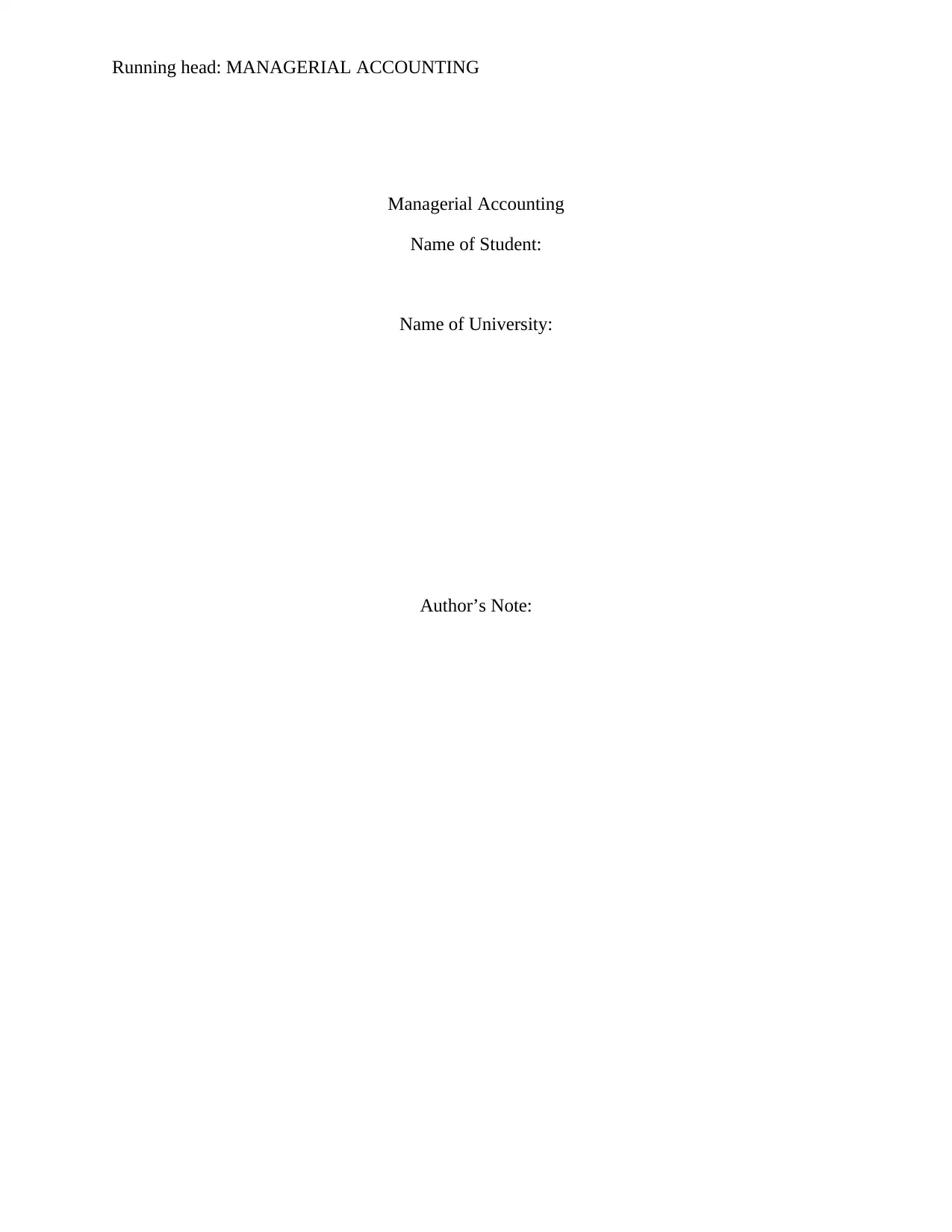
Managerial Accounting
Name of Student:
Name of University:
Author’s Note:
Paraphrase This Document
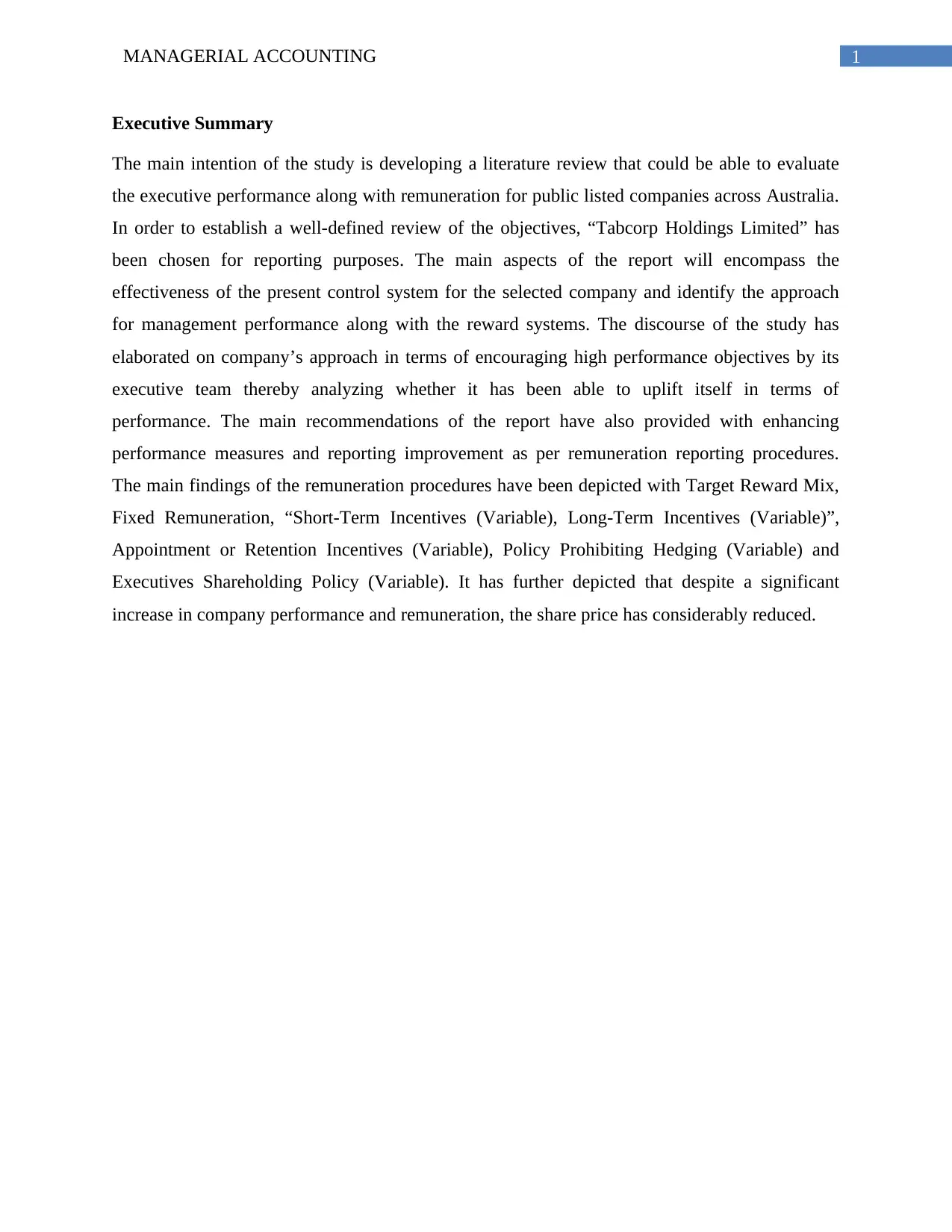
Executive Summary
The main intention of the study is developing a literature review that could be able to evaluate
the executive performance along with remuneration for public listed companies across Australia.
In order to establish a well-defined review of the objectives, “Tabcorp Holdings Limited” has
been chosen for reporting purposes. The main aspects of the report will encompass the
effectiveness of the present control system for the selected company and identify the approach
for management performance along with the reward systems. The discourse of the study has
elaborated on company’s approach in terms of encouraging high performance objectives by its
executive team thereby analyzing whether it has been able to uplift itself in terms of
performance. The main recommendations of the report have also provided with enhancing
performance measures and reporting improvement as per remuneration reporting procedures.
The main findings of the remuneration procedures have been depicted with Target Reward Mix,
Fixed Remuneration, “Short-Term Incentives (Variable), Long-Term Incentives (Variable)”,
Appointment or Retention Incentives (Variable), Policy Prohibiting Hedging (Variable) and
Executives Shareholding Policy (Variable). It has further depicted that despite a significant
increase in company performance and remuneration, the share price has considerably reduced.
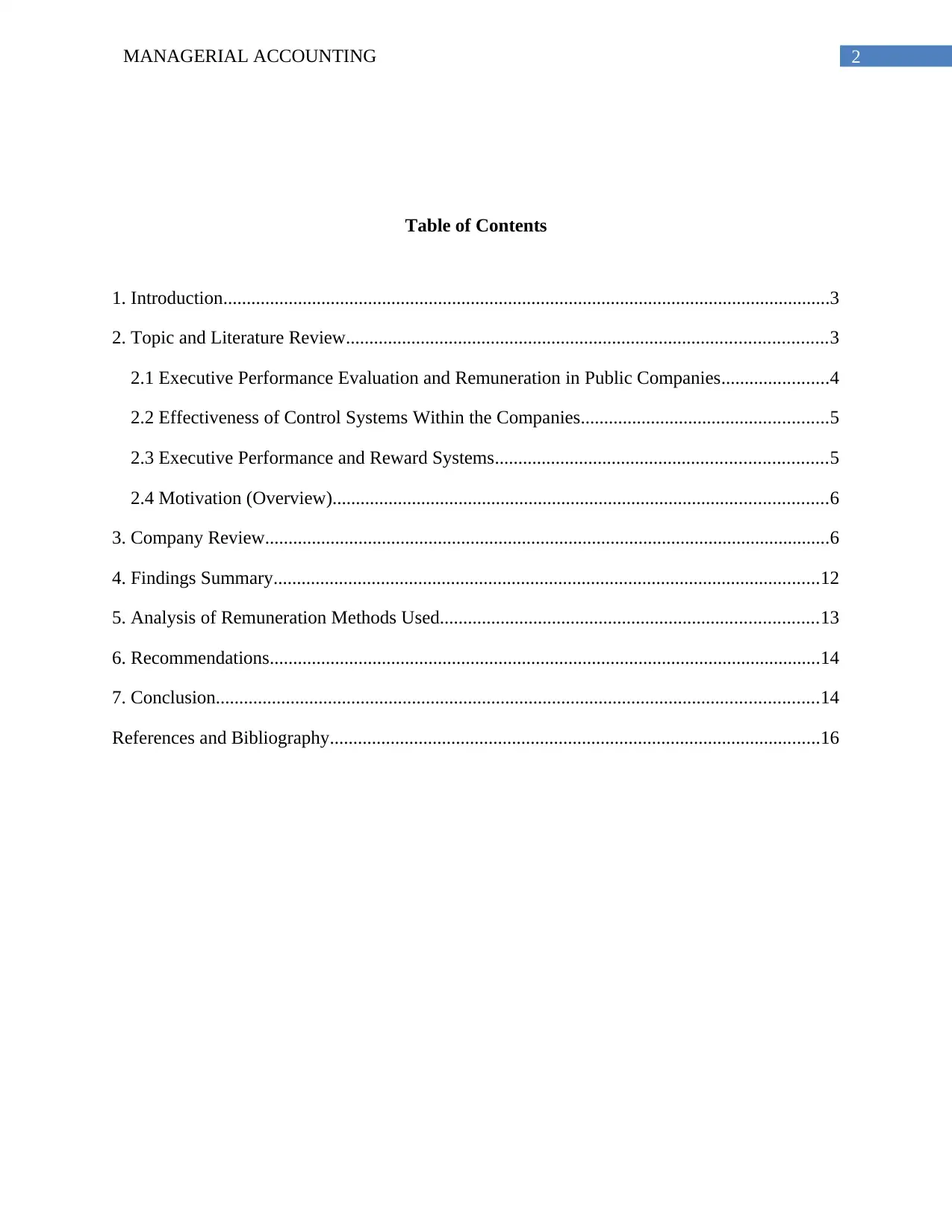
Table of Contents
1. Introduction..................................................................................................................................3
2. Topic and Literature Review.......................................................................................................3
2.1 Executive Performance Evaluation and Remuneration in Public Companies.......................4
2.2 Effectiveness of Control Systems Within the Companies.....................................................5
2.3 Executive Performance and Reward Systems.......................................................................5
2.4 Motivation (Overview)..........................................................................................................6
3. Company Review.........................................................................................................................6
4. Findings Summary.....................................................................................................................12
5. Analysis of Remuneration Methods Used.................................................................................13
6. Recommendations......................................................................................................................14
7. Conclusion.................................................................................................................................14
References and Bibliography.........................................................................................................16
⊘ This is a preview!⊘
Do you want full access?
Subscribe today to unlock all pages.

Trusted by 1+ million students worldwide
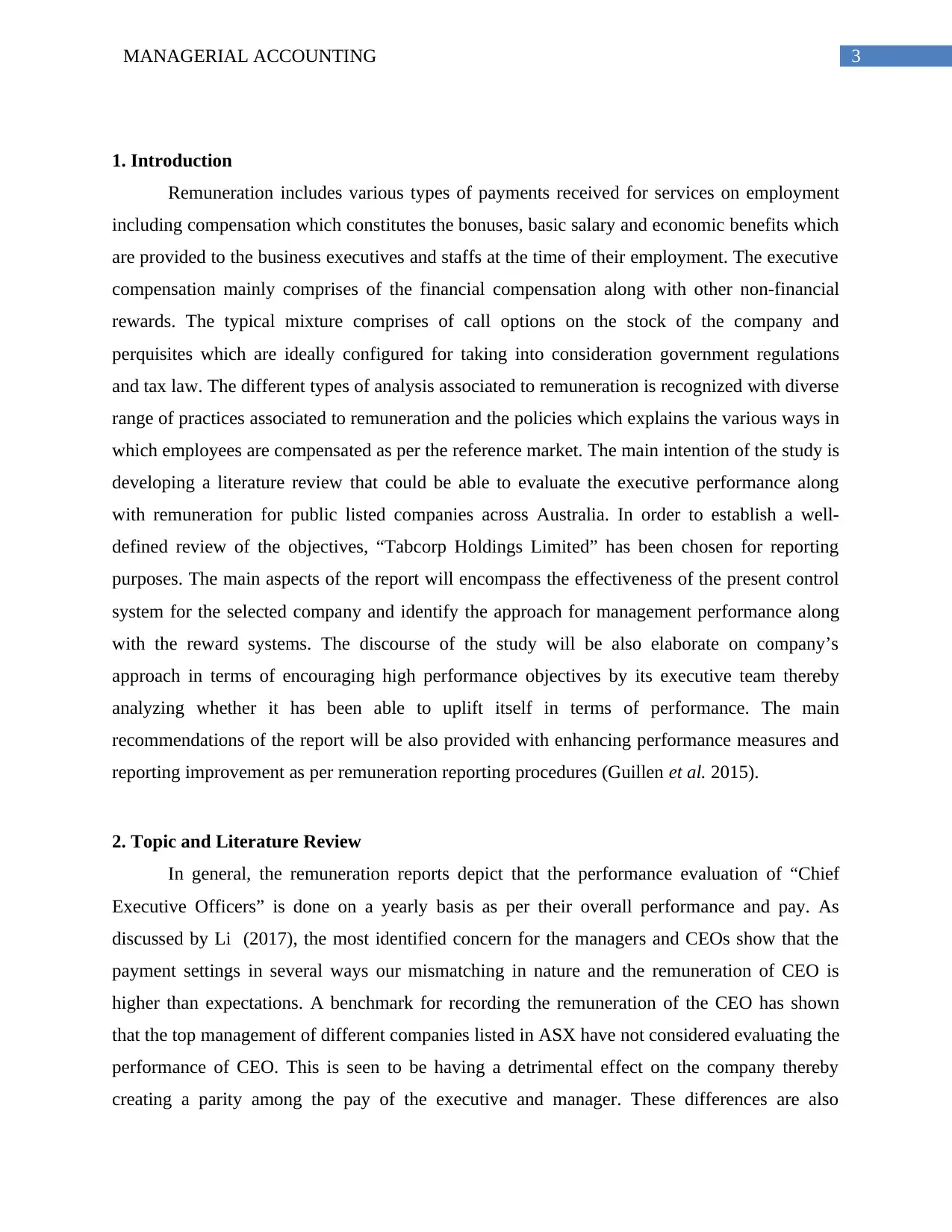
1. Introduction
Remuneration includes various types of payments received for services on employment
including compensation which constitutes the bonuses, basic salary and economic benefits which
are provided to the business executives and staffs at the time of their employment. The executive
compensation mainly comprises of the financial compensation along with other non-financial
rewards. The typical mixture comprises of call options on the stock of the company and
perquisites which are ideally configured for taking into consideration government regulations
and tax law. The different types of analysis associated to remuneration is recognized with diverse
range of practices associated to remuneration and the policies which explains the various ways in
which employees are compensated as per the reference market. The main intention of the study is
developing a literature review that could be able to evaluate the executive performance along
with remuneration for public listed companies across Australia. In order to establish a well-
defined review of the objectives, “Tabcorp Holdings Limited” has been chosen for reporting
purposes. The main aspects of the report will encompass the effectiveness of the present control
system for the selected company and identify the approach for management performance along
with the reward systems. The discourse of the study will be also elaborate on company’s
approach in terms of encouraging high performance objectives by its executive team thereby
analyzing whether it has been able to uplift itself in terms of performance. The main
recommendations of the report will be also provided with enhancing performance measures and
reporting improvement as per remuneration reporting procedures (Guillen et al. 2015).
2. Topic and Literature Review
In general, the remuneration reports depict that the performance evaluation of “Chief
Executive Officers” is done on a yearly basis as per their overall performance and pay. As
discussed by Li (2017), the most identified concern for the managers and CEOs show that the
payment settings in several ways our mismatching in nature and the remuneration of CEO is
higher than expectations. A benchmark for recording the remuneration of the CEO has shown
that the top management of different companies listed in ASX have not considered evaluating the
performance of CEO. This is seen to be having a detrimental effect on the company thereby
creating a parity among the pay of the executive and manager. These differences are also
Paraphrase This Document
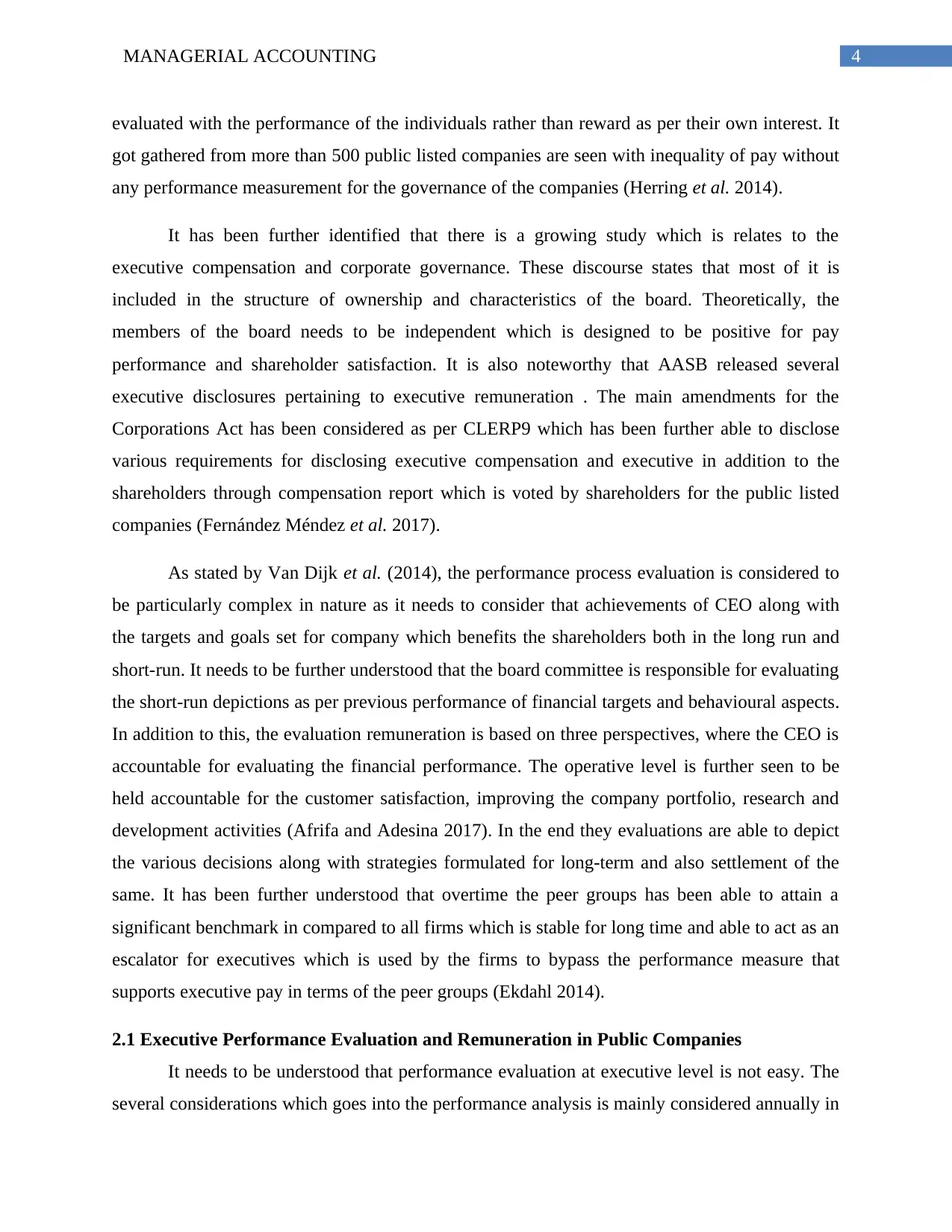
evaluated with the performance of the individuals rather than reward as per their own interest. It
got gathered from more than 500 public listed companies are seen with inequality of pay without
any performance measurement for the governance of the companies (Herring et al. 2014).
It has been further identified that there is a growing study which is relates to the
executive compensation and corporate governance. These discourse states that most of it is
included in the structure of ownership and characteristics of the board. Theoretically, the
members of the board needs to be independent which is designed to be positive for pay
performance and shareholder satisfaction. It is also noteworthy that AASB released several
executive disclosures pertaining to executive remuneration . The main amendments for the
Corporations Act has been considered as per CLERP9 which has been further able to disclose
various requirements for disclosing executive compensation and executive in addition to the
shareholders through compensation report which is voted by shareholders for the public listed
companies (Fernández Méndez et al. 2017).
As stated by Van Dijk et al. (2014), the performance process evaluation is considered to
be particularly complex in nature as it needs to consider that achievements of CEO along with
the targets and goals set for company which benefits the shareholders both in the long run and
short-run. It needs to be further understood that the board committee is responsible for evaluating
the short-run depictions as per previous performance of financial targets and behavioural aspects.
In addition to this, the evaluation remuneration is based on three perspectives, where the CEO is
accountable for evaluating the financial performance. The operative level is further seen to be
held accountable for the customer satisfaction, improving the company portfolio, research and
development activities (Afrifa and Adesina 2017). In the end they evaluations are able to depict
the various decisions along with strategies formulated for long-term and also settlement of the
same. It has been further understood that overtime the peer groups has been able to attain a
significant benchmark in compared to all firms which is stable for long time and able to act as an
escalator for executives which is used by the firms to bypass the performance measure that
supports executive pay in terms of the peer groups (Ekdahl 2014).
2.1 Executive Performance Evaluation and Remuneration in Public Companies
It needs to be understood that performance evaluation at executive level is not easy. The
several considerations which goes into the performance analysis is mainly considered annually in
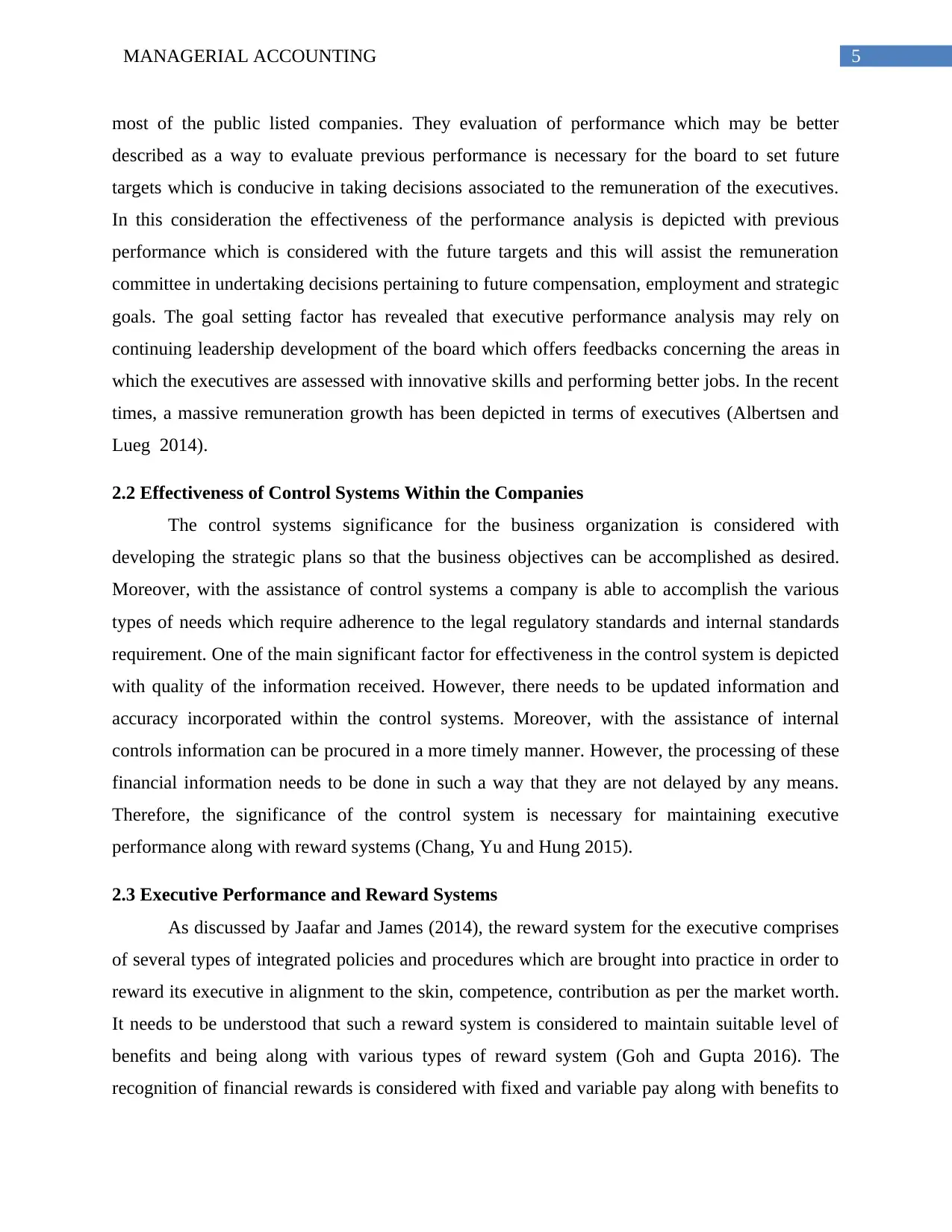
most of the public listed companies. They evaluation of performance which may be better
described as a way to evaluate previous performance is necessary for the board to set future
targets which is conducive in taking decisions associated to the remuneration of the executives.
In this consideration the effectiveness of the performance analysis is depicted with previous
performance which is considered with the future targets and this will assist the remuneration
committee in undertaking decisions pertaining to future compensation, employment and strategic
goals. The goal setting factor has revealed that executive performance analysis may rely on
continuing leadership development of the board which offers feedbacks concerning the areas in
which the executives are assessed with innovative skills and performing better jobs. In the recent
times, a massive remuneration growth has been depicted in terms of executives (Albertsen and
Lueg 2014).
2.2 Effectiveness of Control Systems Within the Companies
The control systems significance for the business organization is considered with
developing the strategic plans so that the business objectives can be accomplished as desired.
Moreover, with the assistance of control systems a company is able to accomplish the various
types of needs which require adherence to the legal regulatory standards and internal standards
requirement. One of the main significant factor for effectiveness in the control system is depicted
with quality of the information received. However, there needs to be updated information and
accuracy incorporated within the control systems. Moreover, with the assistance of internal
controls information can be procured in a more timely manner. However, the processing of these
financial information needs to be done in such a way that they are not delayed by any means.
Therefore, the significance of the control system is necessary for maintaining executive
performance along with reward systems (Chang, Yu and Hung 2015).
2.3 Executive Performance and Reward Systems
As discussed by Jaafar and James (2014), the reward system for the executive comprises
of several types of integrated policies and procedures which are brought into practice in order to
reward its executive in alignment to the skin, competence, contribution as per the market worth.
It needs to be understood that such a reward system is considered to maintain suitable level of
benefits and being along with various types of reward system (Goh and Gupta 2016). The
recognition of financial rewards is considered with fixed and variable pay along with benefits to
⊘ This is a preview!⊘
Do you want full access?
Subscribe today to unlock all pages.

Trusted by 1+ million students worldwide

employee pertaining to overall remuneration. The various elements of the executive
remuneration are also identified with non-financial rewards which is discerned with recognition,
responsibility, achievements and praise. These are considered with individual growth and
management systems performance. There are major ways in which the system of reward
comprises of procedures for measuring the personal contribution and job values within the jobs
along with a range of benefits provided to the employee. Such benefits include market-rate and
job analyses based on performance management. Some of the other empirical research has stated
that there are certain performance rewards which motivates the employees to work to their best
of their ability and retain as the best employee with identifying the rewarding system as part of
their contribution. Some of the major issues faced by the managers during the reward
management and performance evaluation is recognized with getting out the performance
management which is more logical to both implied and employees along with attainment of
organizational goals (Dawid, Harting and Van Der Hoog 2018).
2.4 Motivation (Overview)
The remuneration philosophy of Tabcorp Holdings has revealed that it aims to extract,
motivate and retain individuals with high-calibre throughout the organization by following a
competitive and consistent business objective which are normally accepted as a good market
practice. The key principles under the remuneration has revealed generating “long-term
shareholder value”, “driving performance, ensuring market competitiveness and driving the right
behaviour”. In reference to “creating long-term shareholder value” the company aims to reward
the executives by taking the individual’s performance which are aligned with the business
objectives (Doran et al. 2014).
3. Company Review
The review of remuneration framework by Tabcorp Holdings have revealed that the
“executives and senior management” is profoundly relied on variable performance which is
connected to the segregation of the remuneration at risk and fixed remuneration. The “at-risk”
remuneration is relied on the different types of achievements of the executives targeted with
creating long-term sustained shareholder value. This is further evaluated in terms of delivering
performance rights restricted with shares and cash. In addition to this, the fixed remuneration is
Paraphrase This Document
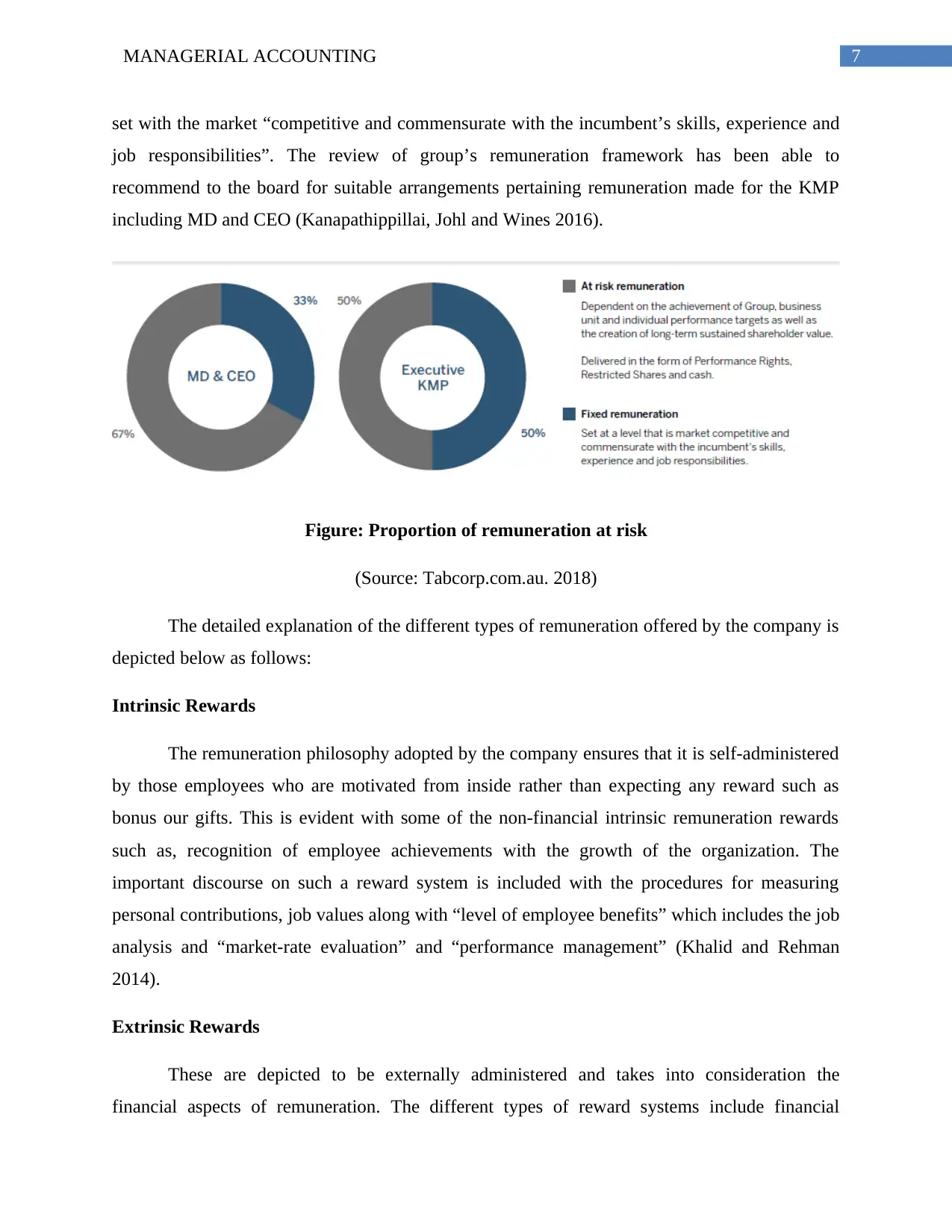
set with the market “competitive and commensurate with the incumbent’s skills, experience and
job responsibilities”. The review of group’s remuneration framework has been able to
recommend to the board for suitable arrangements pertaining remuneration made for the KMP
including MD and CEO (Kanapathippillai, Johl and Wines 2016).
Figure: Proportion of remuneration at risk
(Source: Tabcorp.com.au. 2018)
The detailed explanation of the different types of remuneration offered by the company is
depicted below as follows:
Intrinsic Rewards
The remuneration philosophy adopted by the company ensures that it is self-administered
by those employees who are motivated from inside rather than expecting any reward such as
bonus our gifts. This is evident with some of the non-financial intrinsic remuneration rewards
such as, recognition of employee achievements with the growth of the organization. The
important discourse on such a reward system is included with the procedures for measuring
personal contributions, job values along with “level of employee benefits” which includes the job
analysis and “market-rate evaluation” and “performance management” (Khalid and Rehman
2014).
Extrinsic Rewards
These are depicted to be externally administered and takes into consideration the
financial aspects of remuneration. The different types of reward systems include financial
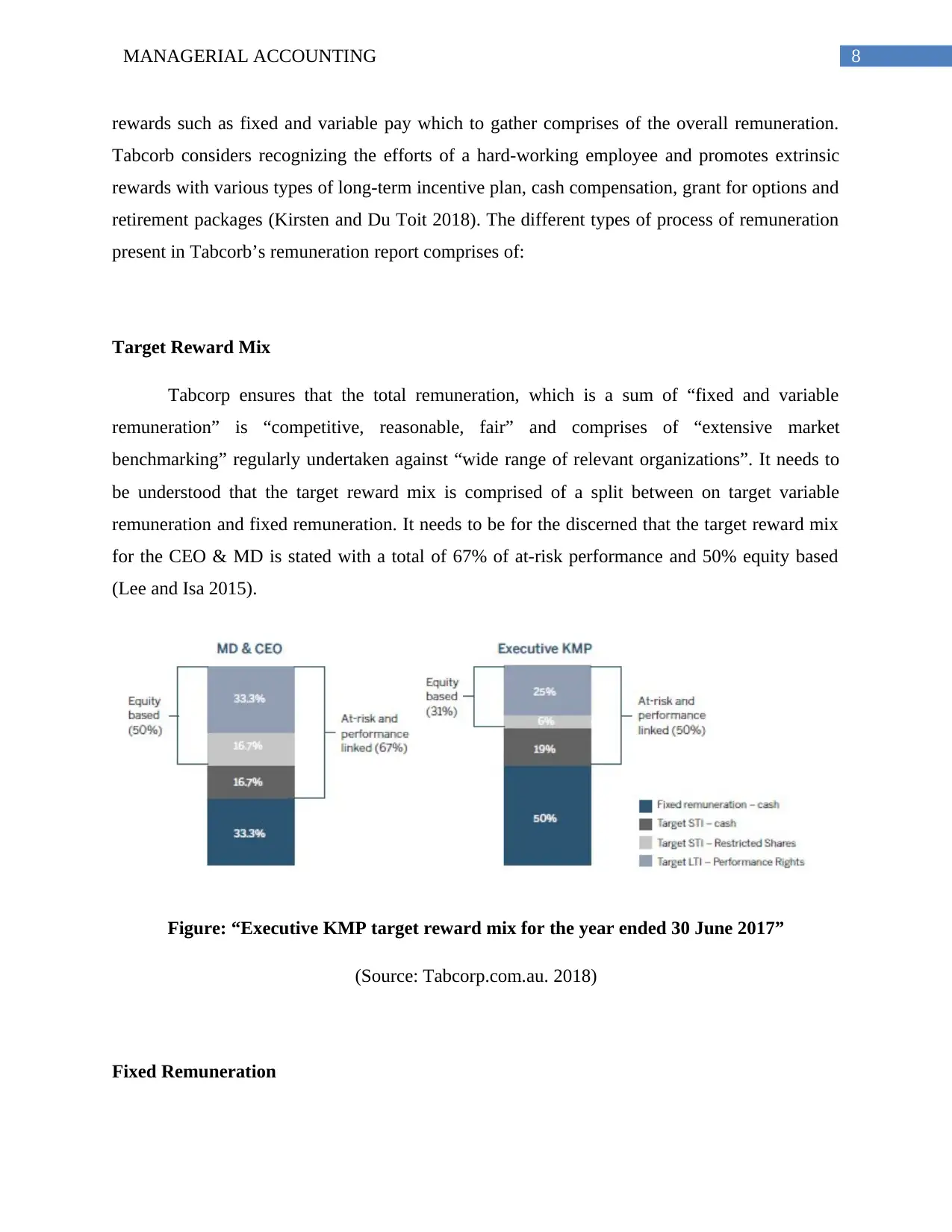
rewards such as fixed and variable pay which to gather comprises of the overall remuneration.
Tabcorb considers recognizing the efforts of a hard-working employee and promotes extrinsic
rewards with various types of long-term incentive plan, cash compensation, grant for options and
retirement packages (Kirsten and Du Toit 2018). The different types of process of remuneration
present in Tabcorb’s remuneration report comprises of:
Target Reward Mix
Tabcorp ensures that the total remuneration, which is a sum of “fixed and variable
remuneration” is “competitive, reasonable, fair” and comprises of “extensive market
benchmarking” regularly undertaken against “wide range of relevant organizations”. It needs to
be understood that the target reward mix is comprised of a split between on target variable
remuneration and fixed remuneration. It needs to be for the discerned that the target reward mix
for the CEO & MD is stated with a total of 67% of at-risk performance and 50% equity based
(Lee and Isa 2015).
Figure: “Executive KMP target reward mix for the year ended 30 June 2017”
(Source: Tabcorp.com.au. 2018)
Fixed Remuneration
⊘ This is a preview!⊘
Do you want full access?
Subscribe today to unlock all pages.

Trusted by 1+ million students worldwide
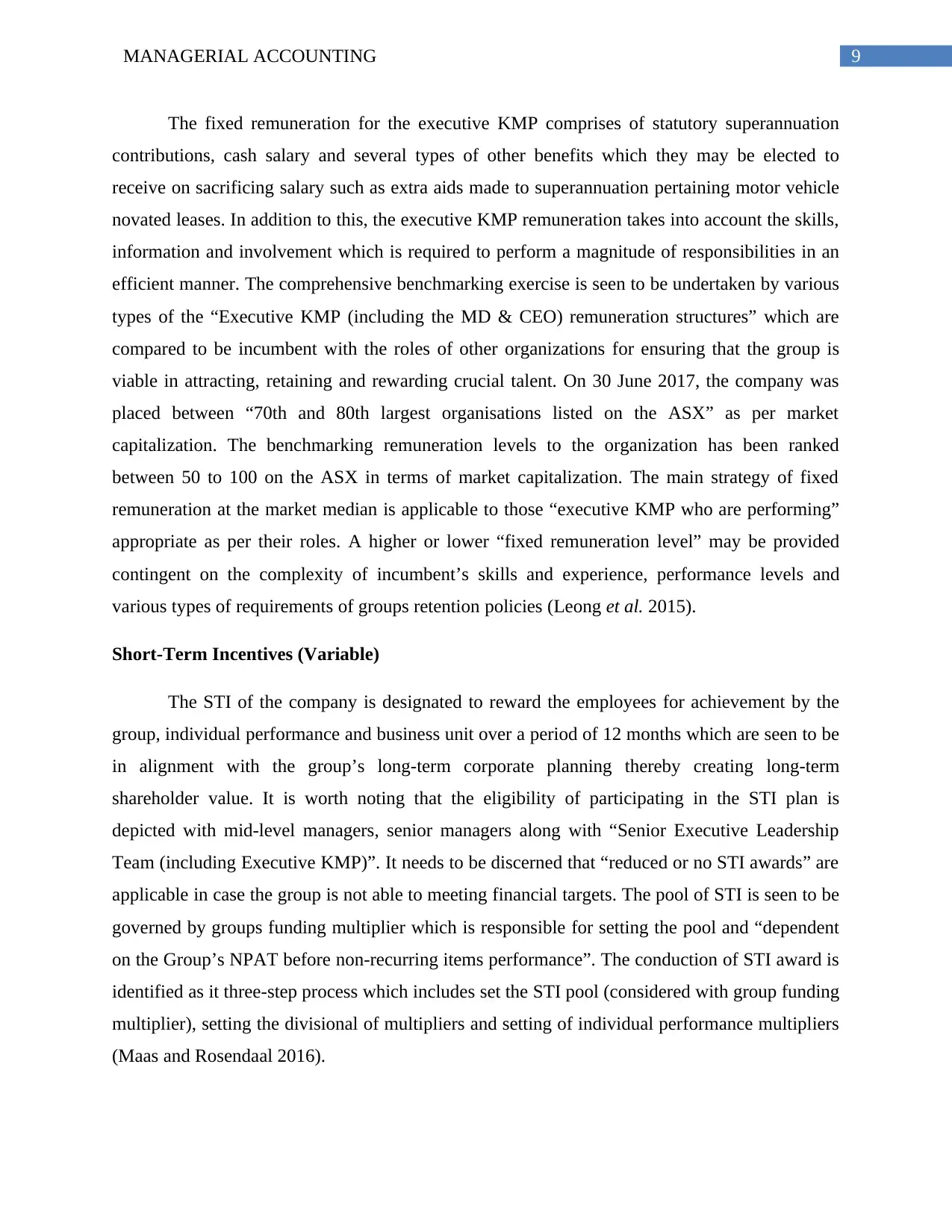
The fixed remuneration for the executive KMP comprises of statutory superannuation
contributions, cash salary and several types of other benefits which they may be elected to
receive on sacrificing salary such as extra aids made to superannuation pertaining motor vehicle
novated leases. In addition to this, the executive KMP remuneration takes into account the skills,
information and involvement which is required to perform a magnitude of responsibilities in an
efficient manner. The comprehensive benchmarking exercise is seen to be undertaken by various
types of the “Executive KMP (including the MD & CEO) remuneration structures” which are
compared to be incumbent with the roles of other organizations for ensuring that the group is
viable in attracting, retaining and rewarding crucial talent. On 30 June 2017, the company was
placed between “70th and 80th largest organisations listed on the ASX” as per market
capitalization. The benchmarking remuneration levels to the organization has been ranked
between 50 to 100 on the ASX in terms of market capitalization. The main strategy of fixed
remuneration at the market median is applicable to those “executive KMP who are performing”
appropriate as per their roles. A higher or lower “fixed remuneration level” may be provided
contingent on the complexity of incumbent’s skills and experience, performance levels and
various types of requirements of groups retention policies (Leong et al. 2015).
Short-Term Incentives (Variable)
The STI of the company is designated to reward the employees for achievement by the
group, individual performance and business unit over a period of 12 months which are seen to be
in alignment with the group’s long-term corporate planning thereby creating long-term
shareholder value. It is worth noting that the eligibility of participating in the STI plan is
depicted with mid-level managers, senior managers along with “Senior Executive Leadership
Team (including Executive KMP)”. It needs to be discerned that “reduced or no STI awards” are
applicable in case the group is not able to meeting financial targets. The pool of STI is seen to be
governed by groups funding multiplier which is responsible for setting the pool and “dependent
on the Group’s NPAT before non-recurring items performance”. The conduction of STI award is
identified as it three-step process which includes set the STI pool (considered with group funding
multiplier), setting the divisional of multipliers and setting of individual performance multipliers
(Maas and Rosendaal 2016).
Paraphrase This Document
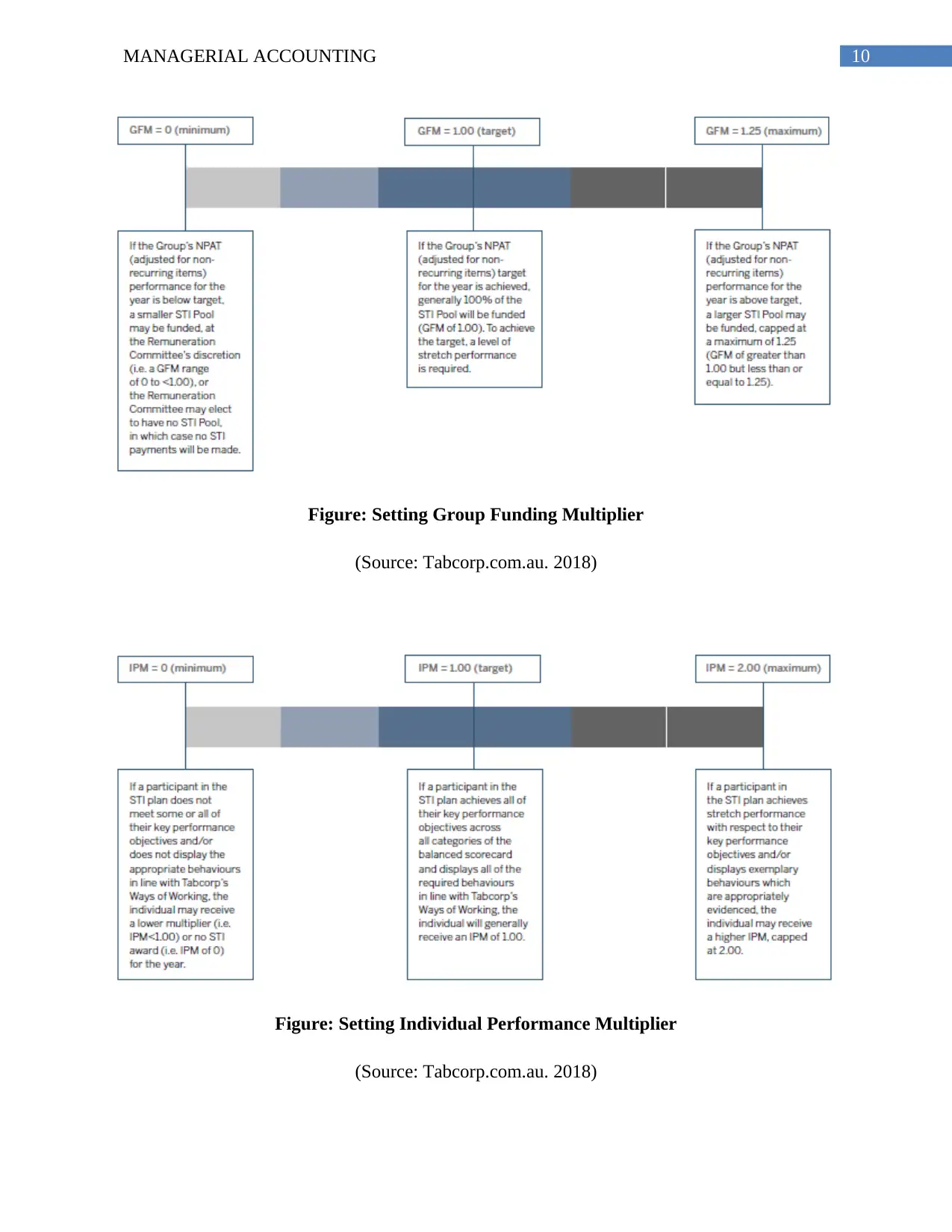
Figure: Setting Group Funding Multiplier
(Source: Tabcorp.com.au. 2018)
Figure: Setting Individual Performance Multiplier
(Source: Tabcorp.com.au. 2018)
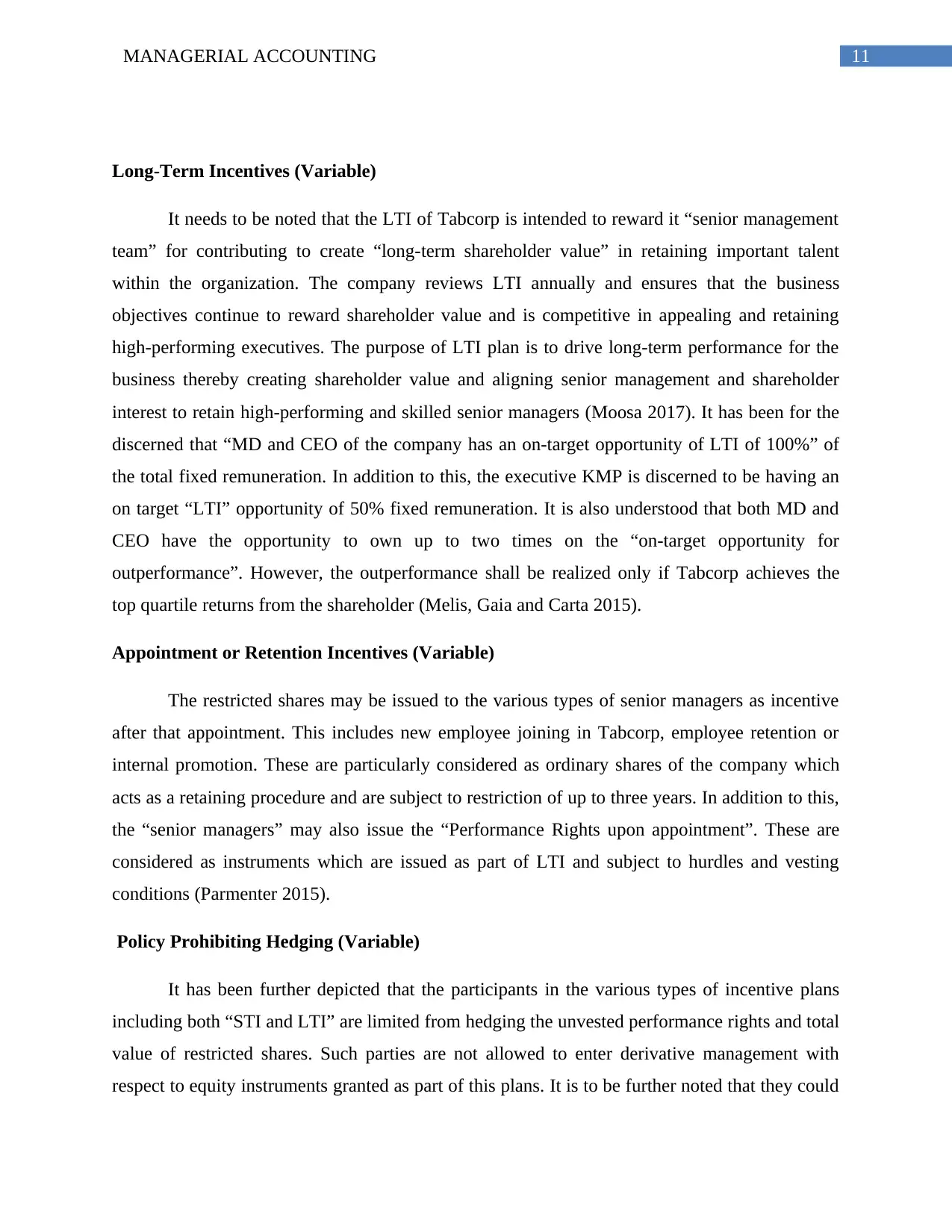
Long-Term Incentives (Variable)
It needs to be noted that the LTI of Tabcorp is intended to reward it “senior management
team” for contributing to create “long-term shareholder value” in retaining important talent
within the organization. The company reviews LTI annually and ensures that the business
objectives continue to reward shareholder value and is competitive in appealing and retaining
high-performing executives. The purpose of LTI plan is to drive long-term performance for the
business thereby creating shareholder value and aligning senior management and shareholder
interest to retain high-performing and skilled senior managers (Moosa 2017). It has been for the
discerned that “MD and CEO of the company has an on-target opportunity of LTI of 100%” of
the total fixed remuneration. In addition to this, the executive KMP is discerned to be having an
on target “LTI” opportunity of 50% fixed remuneration. It is also understood that both MD and
CEO have the opportunity to own up to two times on the “on-target opportunity for
outperformance”. However, the outperformance shall be realized only if Tabcorp achieves the
top quartile returns from the shareholder (Melis, Gaia and Carta 2015).
Appointment or Retention Incentives (Variable)
The restricted shares may be issued to the various types of senior managers as incentive
after that appointment. This includes new employee joining in Tabcorp, employee retention or
internal promotion. These are particularly considered as ordinary shares of the company which
acts as a retaining procedure and are subject to restriction of up to three years. In addition to this,
the “senior managers” may also issue the “Performance Rights upon appointment”. These are
considered as instruments which are issued as part of LTI and subject to hurdles and vesting
conditions (Parmenter 2015).
Policy Prohibiting Hedging (Variable)
It has been further depicted that the participants in the various types of incentive plans
including both “STI and LTI” are limited from hedging the unvested performance rights and total
value of restricted shares. Such parties are not allowed to enter derivative management with
respect to equity instruments granted as part of this plans. It is to be further noted that they could
⊘ This is a preview!⊘
Do you want full access?
Subscribe today to unlock all pages.

Trusted by 1+ million students worldwide

instruments which are granted under such “incentive plans” can only be listed in the name of
participant and considered to be non-tradable as per the share registered and that “cannot be
traded or transferred” to other party until such trading restriction has expired.
Executives Shareholding Policy (Variable)
These policies apply to all the members of “senior executive leadership team counting
executive KMP” and CEO. This remuneration policy purposes are to ensure that there is
sufficient degree of alignment among the executive’s remuneration in shares of the company
through equity ownership. It needs to be further understood that the MD & CEO are required to
hold equivalent amount of the times that “annual fixed remuneration” invested in shares of the
company. Among these two investments one time is observed as annual fixed remuneration and
the remainder of “Senior Executive Leadership Team, including other Executive KMP”. It needs
to be further understood that “minimum shareholding must be achieved within five years from 1
July 2016 (for existing executives)” (Provasi and Riva 2016).
4. Findings Summary
The overall findings on the methods implemented for remuneration states that Tabcorp is
“deemed to be effective” in bringing improved performance both for the “company as well as its
KMP executives”. The overall depictions have been able to state that Tabcorp has distributed the
payment of remuneration information pertaining to various types of long-term, short-term and
retention-based schemes. Based on the depictions of current remuneration for executive KMP it
is discerned that executive director David Attenborough (CEO and managing director) received a
salary and fees of $ 1205384 in 2017 compared to $ 1080692 in 2016. The total cash bonus
received by the CEO and MD of Tabcorp is depicted to be 495000 in 2016 along with accrued
leave benefits of $ 36320 in 2016 compared to $ 79812 and 2017. In addition to this, the
superannuation benefits have been depicted to be $ 1304812 and 2017 compared to $ 1631320 in
2016. The restricted shares of the company are depicted to be $ 305376 and 2017 and $382377 in
2016. It has been further discerned that current executives such as chief financial officer Damien
Johnston received remuneration of $ 662980 and 2017 compared to $ 648839 in 2016. The chief
operating officer of the company Craig Nugent is depicted to receive $ 68149 in 2017 compared
to $ 672567 in 2016. Additionally, Craig Nugent was entitled to a cash bonus amount into $
Paraphrase This Document

187718 in 2016. The total amount of long-term incentives of the chief operating officer includes
$ 14528 in 2017 versus $ 24234 in 2016. The remuneration package of some of the nonexecutive
directors of the company is depicted to be $ 100000 for Paula Dwyer, $ 54,166 for Elmer Funke
Kupper and $ 91,949 for Zygmunt Switkowski.
5. Analysis of Remuneration Methods Used
The depictions of the “annual report of Tabcorp” has been able to suggest that 2017 had
been an excellent year for the company and its related shareholders. Some of the main rationale
for such a statement has been identified with “creating long-term shareholder value, driving
performance, ensuring market competitiveness and driving the right behaviors”. It needs to be
further understood that the fixed remuneration increases their provided different considerations
for “budgets, economic indicators, market benchmarks”, rules and responsibility and complexity
as the encumbrance performance. In addition to this, the actual increase of remuneration of MD
and CEO is discerned to be 13.6% and average increase of executive KMP excluding MD &
CEO is discerned to be 1.9%. The total fixed remuneration of executive KMP is identified with
50% of fixed remuneration with maximum of two times target opportunity. The LTI test date for
the company is further depicted as “18 September 2016 for the 2013 LTI grant”. In addition to
this, the location of the performance rights the explained to the MD and CEO followed with the
approval of shareholder in the annual general meeting conducted in 2016. In this meeting, a
maximum of 501002 performance rights there seem to be allocated. This comprised of a
maximum of 401570 performance rights. It needs to be further understood that LTI test date is
set on 16 September 2017 which is fixed with the 2014 LTI grant. Vesting on this grant is
dilutive to the performance of the company in respect to peer group over a three-year
performance period (Razali et al. 2018).
Despite of the significant benefits provided to the executive KMP remuneration and CEO
and MD remuneration, the company suffers from decreasing share price during the last three
years. It has been discerned that in 2015 the share price was $ 4.55 per share which increased to
$ 4.57 per share in 2016 but drastically reduced to $ 4.37 in 2017. Henceforth, it needs to be
understood that despite of increasing financial performance in most of the areas and improving

remuneration systems, the company has not been able to position itself in a better way when it
comes to stock market performance (Shields et al. 2015).
6. Recommendations
The important evaluations made from the remuneration report of Tabcorp has been able
to suggest that there are certain effective endorsements which are provided to the company in
terms of enhancing its reporting and broadening the scope of performance measures. The main
recommendations are listed below as follows:
Tabcorp needs to attend performance measurement by considering the information which
are based factually and more emphasis on monitoring the outcomes which are implied in
assessment of “short-term incentives and long-term incentives”.
It needs to be understood that the company should focus on analysing the reporting
performance areas which would consider more number of non-financial performance
measure for intrinsic measures. During reporting Tabcorp needs to always consider as per
raw input of information.
The companies recommended to encompass all the factors for operations ranging from
the concepts of distribution and addressing the lifecycle of the business. Some of the
main inclusions to the report needs to be made with the consideration of employee health
and safety, social responsibility and consideration of security factors.
Significant emphasis needs to be put related to the fundamental risk areas pertaining to
anticipated outcomes of the business, leadership and risk management strategies.
7. Conclusion
Some of the main findings on the report based on company review has stated that senior
management and executive is heavily focused on variable performance which is linked to the
segregation of the remuneration at risk and fixed remuneration. The at-risk remuneration is relied
on the different types of achievements of the executives targeted with creating long-term
sustained shareholder value. This is further evaluated in terms of delivering performance rights
restricted with shares and cash. In addition to this, the fixed remuneration is set with the market
“competitive and commensurate with the incumbent’s skills, experience and job
⊘ This is a preview!⊘
Do you want full access?
Subscribe today to unlock all pages.

Trusted by 1+ million students worldwide
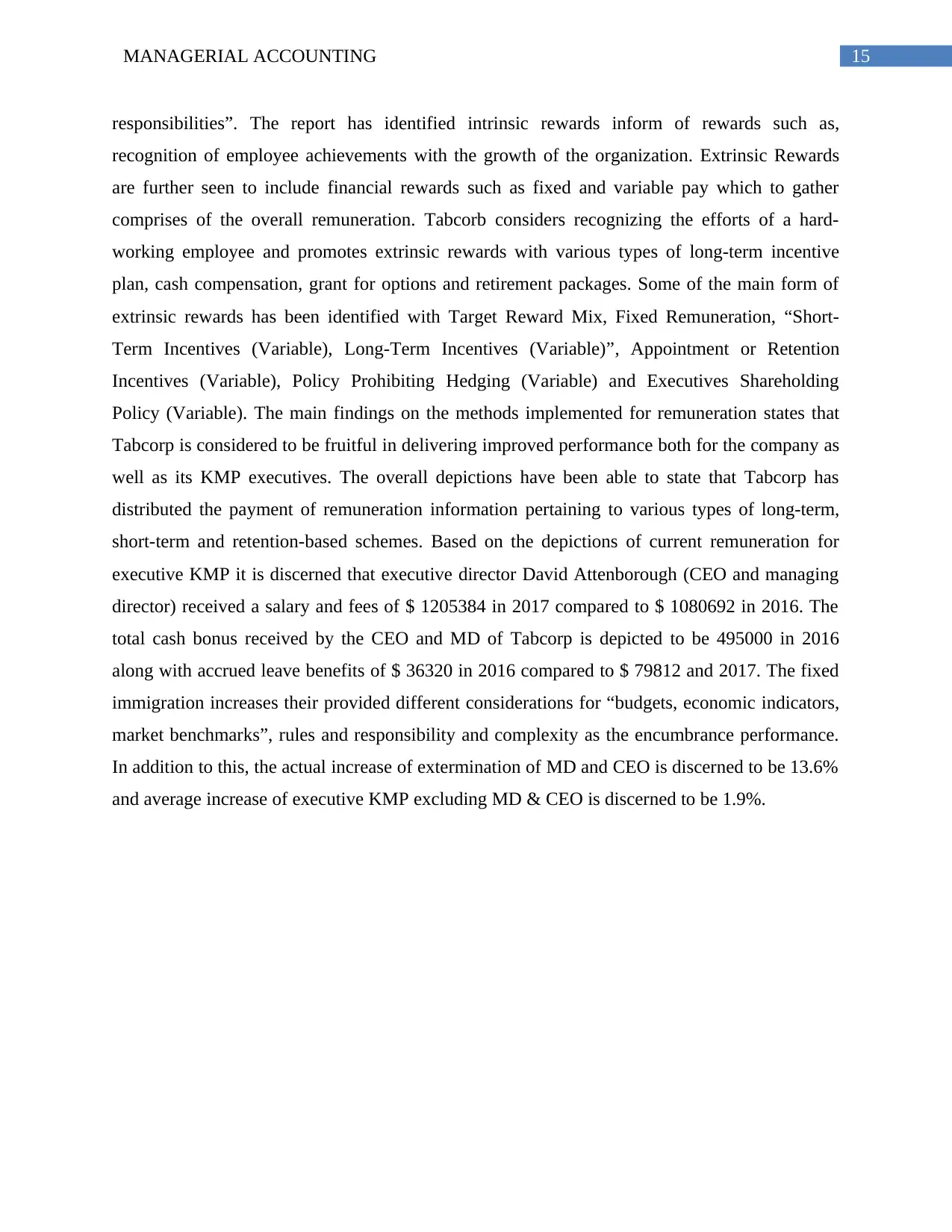
responsibilities”. The report has identified intrinsic rewards inform of rewards such as,
recognition of employee achievements with the growth of the organization. Extrinsic Rewards
are further seen to include financial rewards such as fixed and variable pay which to gather
comprises of the overall remuneration. Tabcorb considers recognizing the efforts of a hard-
working employee and promotes extrinsic rewards with various types of long-term incentive
plan, cash compensation, grant for options and retirement packages. Some of the main form of
extrinsic rewards has been identified with Target Reward Mix, Fixed Remuneration, “Short-
Term Incentives (Variable), Long-Term Incentives (Variable)”, Appointment or Retention
Incentives (Variable), Policy Prohibiting Hedging (Variable) and Executives Shareholding
Policy (Variable). The main findings on the methods implemented for remuneration states that
Tabcorp is considered to be fruitful in delivering improved performance both for the company as
well as its KMP executives. The overall depictions have been able to state that Tabcorp has
distributed the payment of remuneration information pertaining to various types of long-term,
short-term and retention-based schemes. Based on the depictions of current remuneration for
executive KMP it is discerned that executive director David Attenborough (CEO and managing
director) received a salary and fees of $ 1205384 in 2017 compared to $ 1080692 in 2016. The
total cash bonus received by the CEO and MD of Tabcorp is depicted to be 495000 in 2016
along with accrued leave benefits of $ 36320 in 2016 compared to $ 79812 and 2017. The fixed
immigration increases their provided different considerations for “budgets, economic indicators,
market benchmarks”, rules and responsibility and complexity as the encumbrance performance.
In addition to this, the actual increase of extermination of MD and CEO is discerned to be 13.6%
and average increase of executive KMP excluding MD & CEO is discerned to be 1.9%.
Paraphrase This Document

References and Bibliography
Afrifa, G.A. and Adesina, O.O., 2017. How does directors' remuneration affect SMEs'
performance?. Review of Accounting and Finance, (just-accepted), pp.00-00.
Albertsen, O. and Lueg, R., 2014. The balanced scorecard's missing link to compensation: A
literature review and an agenda for future research.
Barontini, R., Bozzi, S. and Ferrarini, G., 2017. Executive remuneration standards and the
“conformity gap” at controlled corporations. Journal of Management & Governance, 21(3),
pp.573-597.
Chang, C.S., Yu, S.W. and Hung, C.H., 2015. Firm risk and performance: the role of corporate
governance. Review of Managerial Science, 9(1), pp.141-173.
Dawid, H., Harting, P. and Van Der Hoog, S., 2018. Data for the Paper: Manager Remuneration,
Share Buybacks and Firm Performance.
Doran, T., Kontopantelis, E., Reeves, D., Sutton, M. and Ryan, A.M., 2014. Setting performance
targets in pay for performance programmes: what can we learn from QOF?. BMJ: British
Medical Journal, 348.
Ekdahl, A.W., 2014. The organisation of hospitals and the remuneration systems are not adapted
to frail old patients giving them bad quality of care and the staff feelings of guilt and
frustration. European Geriatric Medicine, 5(1), pp.35-38.
Fernández Méndez, C., Arrondo García, R. and Pathan, S., 2017. Monitoring by busy and
overlap directors: An examination of executive remuneration and financial reporting
quality. Spanish Journal of Finance and Accounting/Revista Española de Financiación y
Contabilidad, 46(1), pp.28-62.
Geiler, P. and Renneboog, L., 2016. Executive remuneration and the payout decision. Corporate
Governance: An International Review, 24(1), pp.42-63.
Goh, L. and Gupta, A., 2016. Remuneration of non-executive directors: Evidence from the
UK. The British Accounting Review, 48(3), pp.379-399.
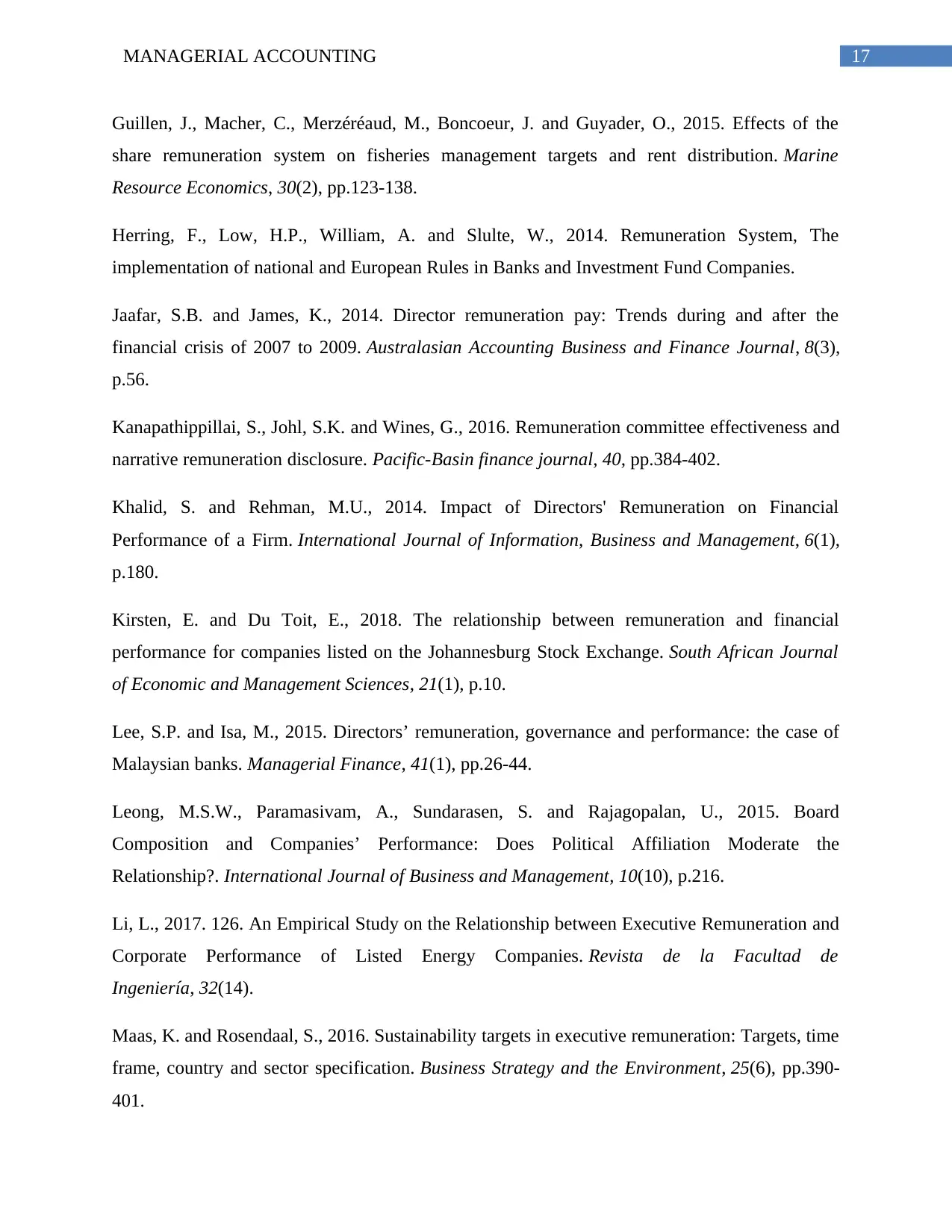
Guillen, J., Macher, C., Merzéréaud, M., Boncoeur, J. and Guyader, O., 2015. Effects of the
share remuneration system on fisheries management targets and rent distribution. Marine
Resource Economics, 30(2), pp.123-138.
Herring, F., Low, H.P., William, A. and Slulte, W., 2014. Remuneration System, The
implementation of national and European Rules in Banks and Investment Fund Companies.
Jaafar, S.B. and James, K., 2014. Director remuneration pay: Trends during and after the
financial crisis of 2007 to 2009. Australasian Accounting Business and Finance Journal, 8(3),
p.56.
Kanapathippillai, S., Johl, S.K. and Wines, G., 2016. Remuneration committee effectiveness and
narrative remuneration disclosure. Pacific-Basin finance journal, 40, pp.384-402.
Khalid, S. and Rehman, M.U., 2014. Impact of Directors' Remuneration on Financial
Performance of a Firm. International Journal of Information, Business and Management, 6(1),
p.180.
Kirsten, E. and Du Toit, E., 2018. The relationship between remuneration and financial
performance for companies listed on the Johannesburg Stock Exchange. South African Journal
of Economic and Management Sciences, 21(1), p.10.
Lee, S.P. and Isa, M., 2015. Directors’ remuneration, governance and performance: the case of
Malaysian banks. Managerial Finance, 41(1), pp.26-44.
Leong, M.S.W., Paramasivam, A., Sundarasen, S. and Rajagopalan, U., 2015. Board
Composition and Companies’ Performance: Does Political Affiliation Moderate the
Relationship?. International Journal of Business and Management, 10(10), p.216.
Li, L., 2017. 126. An Empirical Study on the Relationship between Executive Remuneration and
Corporate Performance of Listed Energy Companies. Revista de la Facultad de
Ingeniería, 32(14).
Maas, K. and Rosendaal, S., 2016. Sustainability targets in executive remuneration: Targets, time
frame, country and sector specification. Business Strategy and the Environment, 25(6), pp.390-
401.
⊘ This is a preview!⊘
Do you want full access?
Subscribe today to unlock all pages.

Trusted by 1+ million students worldwide
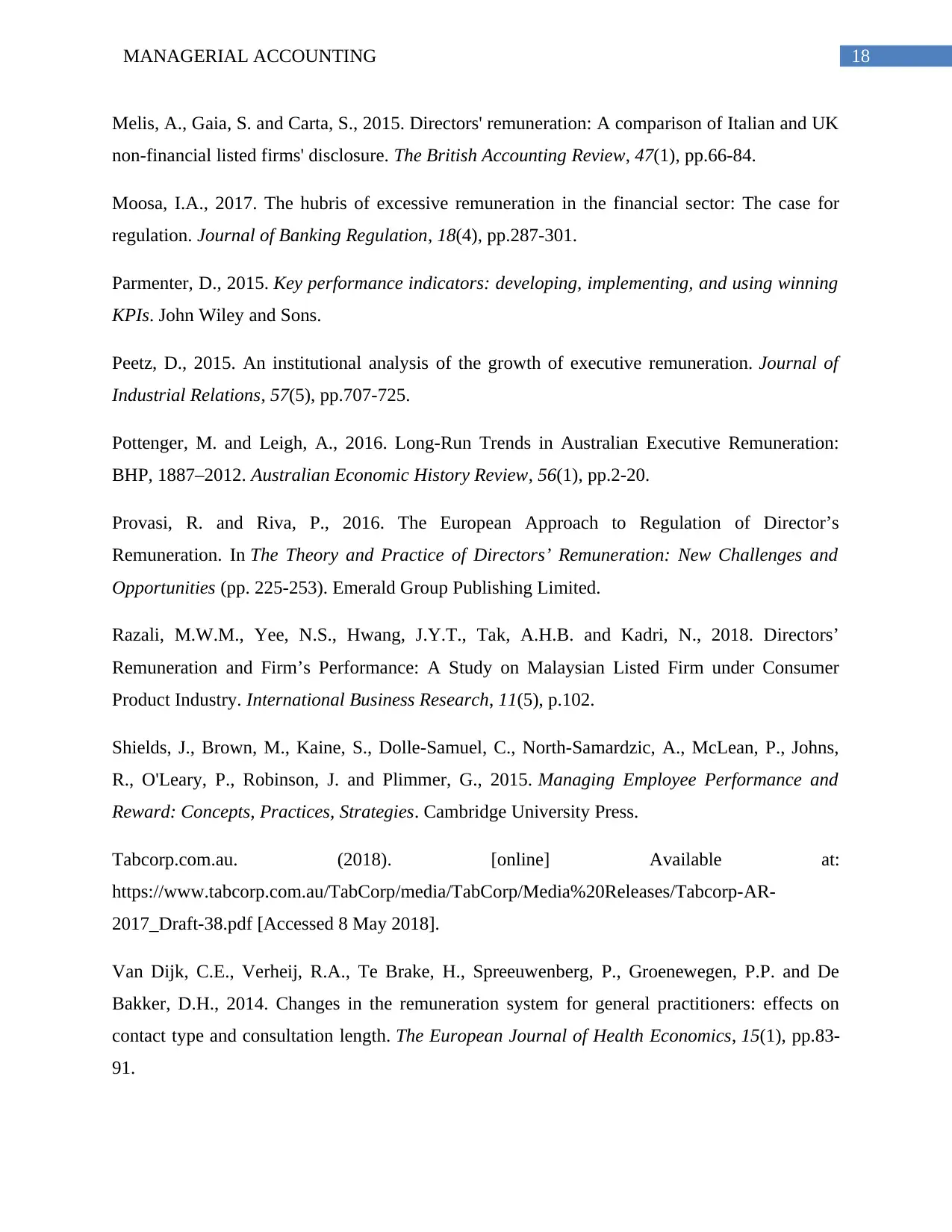
Melis, A., Gaia, S. and Carta, S., 2015. Directors' remuneration: A comparison of Italian and UK
non-financial listed firms' disclosure. The British Accounting Review, 47(1), pp.66-84.
Moosa, I.A., 2017. The hubris of excessive remuneration in the financial sector: The case for
regulation. Journal of Banking Regulation, 18(4), pp.287-301.
Parmenter, D., 2015. Key performance indicators: developing, implementing, and using winning
KPIs. John Wiley and Sons.
Peetz, D., 2015. An institutional analysis of the growth of executive remuneration. Journal of
Industrial Relations, 57(5), pp.707-725.
Pottenger, M. and Leigh, A., 2016. Long‐Run Trends in Australian Executive Remuneration:
BHP, 1887–2012. Australian Economic History Review, 56(1), pp.2-20.
Provasi, R. and Riva, P., 2016. The European Approach to Regulation of Director’s
Remuneration. In The Theory and Practice of Directors’ Remuneration: New Challenges and
Opportunities (pp. 225-253). Emerald Group Publishing Limited.
Razali, M.W.M., Yee, N.S., Hwang, J.Y.T., Tak, A.H.B. and Kadri, N., 2018. Directors’
Remuneration and Firm’s Performance: A Study on Malaysian Listed Firm under Consumer
Product Industry. International Business Research, 11(5), p.102.
Shields, J., Brown, M., Kaine, S., Dolle-Samuel, C., North-Samardzic, A., McLean, P., Johns,
R., O'Leary, P., Robinson, J. and Plimmer, G., 2015. Managing Employee Performance and
Reward: Concepts, Practices, Strategies. Cambridge University Press.
Tabcorp.com.au. (2018). [online] Available at:
https://www.tabcorp.com.au/TabCorp/media/TabCorp/Media%20Releases/Tabcorp-AR-
2017_Draft-38.pdf [Accessed 8 May 2018].
Van Dijk, C.E., Verheij, R.A., Te Brake, H., Spreeuwenberg, P., Groenewegen, P.P. and De
Bakker, D.H., 2014. Changes in the remuneration system for general practitioners: effects on
contact type and consultation length. The European Journal of Health Economics, 15(1), pp.83-
91.
Related Documents
Your All-in-One AI-Powered Toolkit for Academic Success.
+13062052269
info@desklib.com
Available 24*7 on WhatsApp / Email
![[object Object]](/_next/static/media/star-bottom.7253800d.svg)
© 2024 | Zucol Services PVT LTD | All rights reserved.





